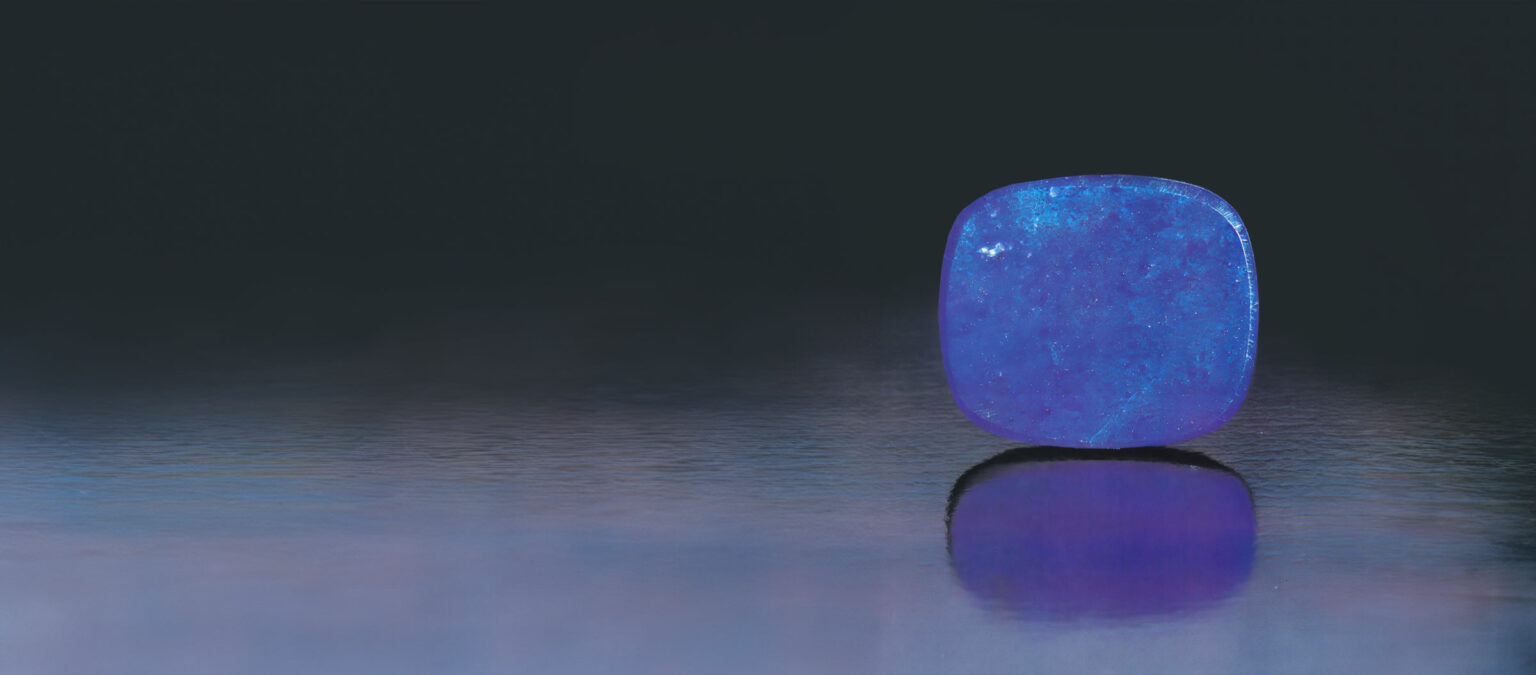During the spring of 1985, lapis lazuli, of all things, became a hot topic on Capitol Hill.
The subject first came up during Senate Armed Services Committee hearings on Afghanistan, the prime source of lapis and the scene of a then-six-year-old war between Moslem rebels and the Soviet-backed government of Babrak Karmal. Moslem freedom fighters testified that sales of lapis rough are a major means by which they now raise cash for arms needed to fight invading Russian troops.
They may well have borrowed the idea from their opponents. In early 1984, the government of Afghanistan advertised an auction for tons of lapis rough. (Since we can find no one who attended the sale, we can give no details on the quality of the material offered or the success, if any, in selling it.)
The idea of using lapis as a cash cow for weapons procurement is a jarring one, a little like learning that Burma rubies are being used for Star Wars lasers guns (which they’re not). After all, lapis has a long association with spiritual attributes. In fact, the ancients mistakenly called it “sapphirus” after its deep heavenly blue color. But, then, come to think of it, Moslems are certainly believers in heaven. So maybe the idea of selling lapis to defend their homeland isn’t so strange. In any case, the Moslem rebels couldn’t have picked a better time to peddle lapis.
Interest in this ornamental stone is as strong as it has ever been. And it is likely to grow stronger as more men take to wearing gems. Indeed, lapis is already a men’s ring mainstay. Lapis leader Seymour Arnstein, Walter Arnstein Inc., New York, thinks there’s no harm in selling the gem as a “freedom stone.”
But if you believe that politics shouldn’t enter into jewelry selling, Arnstein adds that lapis also has economics going for it. And how.
Boulders of Blue
There are literally tons of lapis for sale these days. According to rough dealer Najan Taj, Afghan Gems and Minerals, San Francisco, the European, Asian and American markets are glutted with material. Unfortunately, most of it is poor grade. Out of, say, five tons, Taj estimates that only 10-15 kilos will be decent and as little as two kilos “top quality.” By top quality, most dealers mean stones with a deep uniform blue that are free of white calcite veining the surface and virtually free of more tolerable golden pyrite flecks.
Some lapis lovers, however, like their stones to show pyrite, but they are a minority among connoisseurs. One other plus worth noting: The very best lapis should have a high polish. Since stones vary in hardness, it is possible to encounter fine color and poor polish (evidence of a softer stone). Expect to pay $20-$40 per carat for better-to-fine 14x12mm ovals, currently the most popular size, with either flat or buff (slightly domed) tops.
One notch below fine comes what Arnstein calls “B-grade” lapis. Such stones may be dyed in spots, but never in their entirety, to conceal small patches of calcite. Most of the time, however, they are all natural with either lighter shades of even blue, slight to mild color zoning of darker blues, or, perhaps, some surface cracks.
Last, and far from least, is dyed lapis. Despite waxing to seal in color additives, dyed used in lapis are unstable, especially if exposed to household chemicals such as lighter fluid. Perspiration, perfumes and cosmetics pose a constant threat to dyed lapis beads and many a jeweler has had to put up with returns of dyed lapis necklaces.
Therefore, it is important to ask suppliers if the lapis stones or jewelry pieces they sell you are dyed, especially if you’re buying lapis beads, almost all of which are treated. Often, however, price is a giveaway. “If you’re charged $80 for a 16-inch strand of 8mm beads, most likely it’s treated,” Arnstein cautions. “Decent quality untreated strands of the same length and bead size will run anywhere from $150 to $350.”
But don’t always depend on price to tip you off to treatment. Some ruthless suppliers may ask high prices for treated material to fool you. So spot check stones you’re not sure of by dabbing them with cotton swabs dipped in acetone. Sometimes even licking suspect lapis with the tongue and then wiping the stone on a piece of tissue paper will leave a telltale blue streak.
A Favorite with Men
Lapis is one of the world’s most popular men’s gems, second perhaps only to black onyx. Although far more expensive in top grades than black onyx, lapis is still inexpensive in comparison to prices fetched for it seven to eight years ago. “Fine natural lapis is underpriced,” Arnstein says. “A few years back, it was priced ten times that of treated material. Now dealers are lucky to get four times.”
This ratio, however, shows signs of widening again. The deluge of treated lapis has forced prices down for this material at least 30% in the last year or two. Meanwhile, prices for fine goods have held steady. Some dealers believe that quality-minded jewelers will turn to untreated stones as disclosure of treatment becomes more of an industry norm. This will eventually squeeze prices for limited-supply untreated goods higher.
Manufacturers M.J. talked to insist that they do not use treated lapis, at least not in their rings. We found rings with natural-color 14x12mm ovals running between $300 and $500 wholesale. Earrings with the same-sized ovals were quoted at much less, both because less gold was used with either B-grade or dyed stones. “Quality isn’t generally as important in an earring as it is in a ring,” one New Jersey manufacturer told us.
Occasionally, some very inexpensive lighter grayish-blue lapis from Chile appears on the market, as do too-good-to-be-true synthetic stones. Even more pesky to lapis buyers are blue calcite-veined sodalites from places like America, Canada and Norway. Coating at most a few dollars per carat, these lapis look-alikes can fool the unwary. And no wonder. Both stones belong to the same rock family, sodium aluminum silicate. To make matters worse, sodalite laps up dye as readily as most of its more expensive next of kin. Fortunately, sodalite gives itself away by its lower specific gravity (2.24, on average, versus 2.75, on average).
For the most part, however, jewelers are more likely to see lapis from Afghanistan than sodalite from America. “There’s as much lapis as people want,” Taj says, “provided they want commercial grades.”
Please note: this profile was originally published in 1988 in Modern Jeweler’s ‘Gem Profiles: The First 60’, written by David Federman with photographs by Tino Hammid.
The 4.49-carat lapis lazuli shown in the header image is courtesy of Walter Arnstein Inc., New York.






